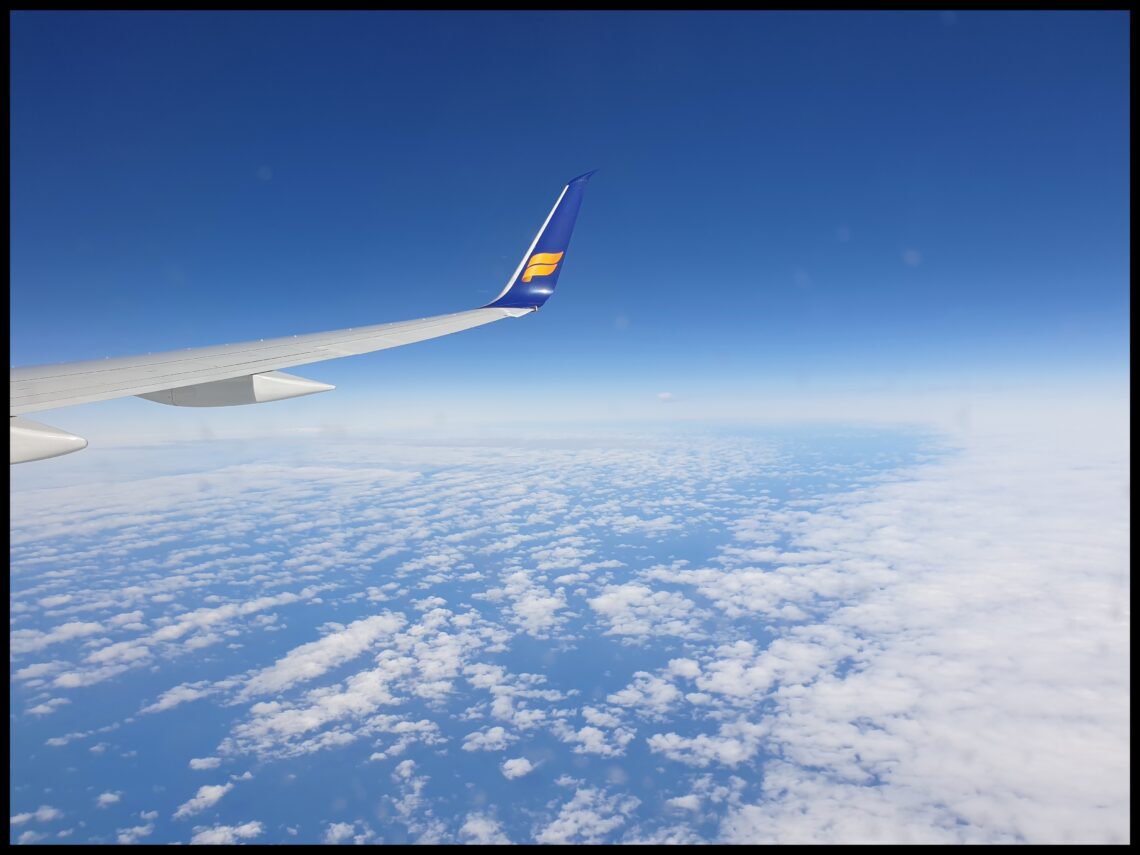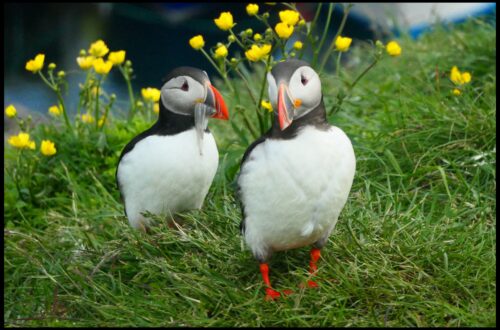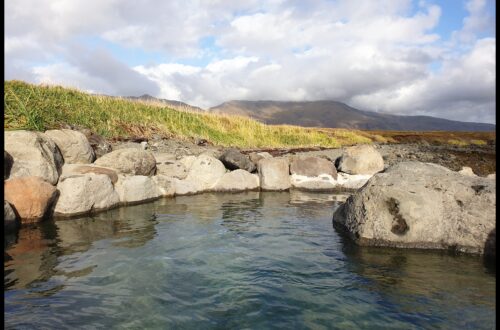
20 frequently asked questions
Your first Iceland trip is coming up? Here are the answers to the most frequently asked questions.
Each season has its pros and cons. In summer (June – August) the days are long, there is plenty of time for activities, bird watching and the highlands are easily accessible. However, the high season is also the most expensive and has the most tourists. Autumn (September – October) is rather short but the colors let the island shine even more beautiful. The days are still long enough for activities but the first storms can already call for a „plan B“ and the highlands are not accessible anymore.
Winter (November – March) is long and dark, storms regularly sweep across the country and road conditions are often difficult. There are only a few hours of daylight, don’t plan too much on a day and be ready for adjustments. As a benefit you will have the chance of icy waterfalls and northern lights. In spring (April – May) many hiking paths and the highland roads are still closed and sometimes it takes a while before the first green can be seen. The days are getting longer and longer, the birds return from their winter quarters. It is still off-season and you are often alone at the sights.
Always varied and unpredictable, usually all four seasons occur in a day. In summer, sun and clouds alternate but rain is always possible. It’s mostly only a short shower but there is practically always a light wind. The temperature in summer is usually between 10° – 20° C, in the sun it sometimes goes even up to 25°. In winter however it doesn’t get as cold as you might think. The temperature during the day is usually between minus and plus 5° C, in the night it can drop much lower of course. Like said before, the weather can vary from sun to storm within minutes every day, be prepared for everything. Snow is only guaranteed in the highlands, expecially in the capital region the snow usually turns quickly into mud.
Iceland is very safe and is regularly rated as the safest country in the world. The crime rate is extremely low and even the police do not carry a gun. In recent years there has been a slight increase in petty crime such as car break-ins, mostly in Reykjavík. As everywhere, it is important not to leave any valuables lying in sight. Otherwise, the unpredictable weather is probably the greatest and most underestimated threat in Iceland.
The official language is Icelandic. But don’t worry, English is already taught at primary school level, which is why basically all Icelanders can now speak English fluently. Danish is also widely spoken and occasionally German, French and Spanish.
It is not worth learning Icelandic for just a short vacation as most Icelanders will switch to English as soon as they realize that you are a tourist.
There are two ways to get to Iceland: by plane or by ferry. More than 20 airlines fly regularly to Iceland, the best known are Icelandair, Lufthansa, Delta and Wizz Air. However, there is only one ferry, the „Norröna“ of Smyril Line runs from Hirtshals in Denmark via the Faroe Islands to Seydisfjördur in the east of Iceland.
It is important to know that international flights land in Keflavík and not at the city/domestic airport. There are two companies that run a bus service from the airport to the BSÍ bus station in Reykjavík and from there to the smaller bus stops in the city center: Reykjavik Excursion („Flybus“) and Grayline Airport Transfer (“Airport direct”). The journey takes approximately 45 minutes and costs around 3‘500 ISK. You can book the ticket in advance or in the arrival hall.
It is also possible to take the public bus „straeto“ (line 55, travel time 65 minutes, price 1‘960 ISK) or a taxi (travel time 45 minutes, price around 150‘000 ISK). Or you go with your own car, most rental companies are represented diretly at the airport or can be reached by shuttle bus.
Of course there is never enough time, but four days are the bare minimum to explore the capital region. If you plan to travel around the ring road I recommend a minimum of ten days. If you also want to include a trip to the highlands or the westfjords you’ll need at least 16 days. Eventhough Iceland is not as big as other countries, travelling often needs much more time than anticipated and I am a strong believer in slow travel, take your time to enjoy the beauty.
It all depends on your personal preference. Do you like to plan yourself and do you feel safe when driving in unfamiliar surroundings and road conditions? Then you can absolutely rent a car and drive yourself. Navigating in Iceland is very easy and you have the freedom to stay at the sights however long you want to.
Would you rather relax and enjoy the landscape without having to worry about where and how to get around? Are you short on time, feel unsure about driving or do you like to listen to a guide’s stories? Then book tours. Also consider to do not only day-tours but multi-day-tours so you don’t have to backtrack to Reykjavík every day and get to know the other travellers a little better.
I have had several good experiences Blue car rental and Holdur (the Icelandic franchise of Europcar). Lotus and Geysir are also popular. I recommend comparing prices and contents of the insurance for the desired period. The further advance you book, the cheaper. A 4×4 car is only necessary for the highlands and the westfjords („F-roads“, partly difficult gravel roads), the ring road is paved the entire route and smaller, gravel side roads ure usually still easy to drive with a 2wd without problems.
The currency in Iceland is the Icelandic krona ISK. 100 ISK corresponds to ca. 0.67 €, 0.57 £ or 0.77 $. 1 € is approx. 150 ISK, 1 £ = 178 ISK and 1 $ = 130 ISK. Iceland is an almost cashless nation, even the smallest amounts such as chewing gum or toilets are paid by card. Never change actual money at a bank, if you want to have a backup just get a little from an ATM at the airport.
But Iceland is also a very expensive country, you should expect around 160 € per day (rough estimate 90 € accomocation, 40 € transportation, 20 € food, 10 € extras). This calculation can of course also look completely different, it all depends on your plans. Eating out in restaurants is particularly expensive, a main meal cots around 25-40 €, at least there is free tap water. You can save money on accomodation (a room with a shared bathroom is much cheaper) and on food (get groceries at bonús, Nettó or Krónan and cook yourself).
Iceland offers the whole spectrum of accomodation, from campsites to luxury hotels. I always recommend family-run guesthouses. They are much mor personal than the big hotels, the hosts look forward to meet people and are happy to provide personal tips for the area. In addition, accomodations with shared bathrooms are often significantly cheaper.
The infrastructure at campsites vary, but ofthen they are rather rudimentary, sometimes you have to pay for the shower with coins. Tjala.is is a website with a lot of information. Be aware that with a camper van/motorhome/tent you always have to stay on official campsites. Wild camping or staying at a normal parking lot overnight is illegal and the fines are heavy. The „campingcard“ is only worth when you plan your trip well, not all campsites take part in the program. A night at a campsite costs around 2‘000 ISK, a single room with a shared bathroom around 11‘000 ISK and a double room with its own bathroom in a mid-range hotel around 30‘000 ISK.
Probably the most Icelandic activity is swimming or rather soaking in the hot tub, there is a swimming pool in pretty much every village. It is also possible to snorkel (everyone) or to scuba dive (only with dry suit certification) in the silfra fissure (a fault caused by the drifting apart of the Eurasian and North American plates).
A highlight for many is a glacier hike, a visit to an ice cave or a boat or kayak tour on a glacier lagoon. Those who prefer something warmer can visit lava tunnels or feel the adrenaline while quad biking or river rafting and the endless number of hiking trails for all fitness levels inspire outdoor enthusiasts. Activities with animals include whale watching (high season from April to October) and horse riding tours (all year round from one hour to multi-day tours into the highlands).
It is very important to be prepared for all weather conditions. Since it often rains and is always windy, water- and windproof rain jackets and pants are compulsory. As base layers take several short and long-sleeved tops and comfortable hiking pants. Merino underwear is always good, the super heavy ski pants are only needed in winter. The shoes should also be waterproof and have a good, sturdy profile, it is often slippery or rocky. Bring sneakers for restaurants, flip-flops for the accomodation. You shoult not forget a hat and gloves (even in summer!), but you can leave the umbrella at home (not helpful in the wind). A flashlight or headlamp can be useful in the winter months, in summer a head net helps against the flies/midges in the north.
Growing grain and vegetables was often difficult in the past due to the harsh climate, still today many products are imported which in turn is reflected in the price. However, nowadays geothermal energy is used to grow vegetables (especially tomatoes, cucumbers and peppers) and flowers in greenhouses. The Icelandic cuisine still leans heavily on meat and fish (lamb, horse, reindeer respectively salmon, haddock, cod). Specialties include whale (often only for tourists) and puffin (tradition on the westman islands). Sometimes you find unusual things on the menu, e.g. svið (sheep’s head) or hákarl (fermented shark). More tourist-friendly dishes are e.g. plokkfiskur (stew made from fish and potatoes) or kjötsupa (lamp soup).
Salty snacks for on the go are hangikjöt (smoked lamb), hardfiskur (dried fish, best with butter), rúgbrauð (dark, sweet rye bread) or the well known yoghurt-like cream cheese skyr. In the afternoon there are kleinur (deep-fried pastries), pönnukökur (crêpes), or sweets with liquorice. In addition, Icelanders love ice cream (in ALL flavors) and hot dogs (lamp, pork and beef sausages with ketchup, remoulade and roasted onions) at any time of the day, night and season.
Tip: gas stations often have a restaurant next to the shop, in which simple dishes (soups, burgers, fries, hot dogs) are offered at reasonable prices. The quality is usually better than expected.
Iceland is a very child-friendly country. There is a lot to discover and in many places children can romp round and climb without problem. Children usually have a lot of fun with animals (e.g. in the small pet zoo in Reykjavík or on a stable visit/riding tour) and when splashing around at rivers and waterfalls. A great activity for children of all ages are the „jumping pillows“ that are scattered all over Iceland. However, some activities (e.g. glacier tours) require an age limit of 6 or 8 years. It is a good idea to create a „travel bucket list“ (for example with tasks like take a picture of the geyser, pet a horse, climb a volcanic crater etc.).
Network coverage in Iceland is basically good but there can be gaps in uninhabited areas (or especially in the highlands). WIFI is available free of charge at most gas stations (in restaurants and hotels anyway). A compass, GPS device and an old fashioned paper map is definitely recommended when hiking in remote areas. Download the parts where you will be from Google Maps before the trip so you are no longer dependent on internet connection and can use them offline.
Depends where you are coming from. In Iceland type C and F sockets are used (standard Europlug with two round prongs), the voltage is 230 volts. Make sure you take a power bank with you when going on longer (hiking) tours, in many mountain huts there is no electricity.
- Veður/vedur.is: weather and northern lights forecast, earthquake activity and other information from the meteorological office
- Safetravel.is: all important information about travel conditions and warnings
- Road.is: detailed road conditions
- Strætó/straeto.is: public bus of Reykjavík and the whole country, convenient to buy tickets
- Appy hour & Icelandic coupons: discounts for bars, restaurants and activities
- AllTrails/alltrails.com: hiking routes with gps-tracking, elevation profile, pictures etc.
- Tipping is not customary and only given when the service and quality are absolutely outstanding.
- Shower naked before entering the pool (genders are separated of course).
- Off-road driving is strictly prohibited. You should also always stay on the trails when hiking. The Icelandic flora is extremely sensitive, moss grows infinitely slowly and traces in it as well as in lava fields can still be seen after decades(!).
- Beaches are no playground. The so-called „sneaker waves“ are very dangerous as they suddenly reach much further inland than expected. Best case your feet get wet, worst case you fall down and the current pulls you into the open sea. Never turn your back to the ocean and watch the waves from a safe distance. Do not let children unattended.
- Don’t buy bottled water. The Icelandic tap water is absolutely fresh and healthy, straight from the glaciers, filtered through layers of lava for years.
That’s easy, everything of course! But joking aside, the top sights of Iceland you can find very easily by googling. My advice to you: don’t try to work off a list or do only, what everyone else does. Read in guide books, look through photographic books, browse Facebook and Instagram, read in this blog and find out, what interests YOU the most. Create your own itinerary. Everything in Iceland is beautiful, so whatever you do or see, it will be wonderful!


You May Also Like

Puffins
21. April 2023
Lagoons & Spas
27. October 2022